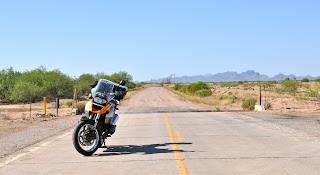Itinerant's Itinerary: Riding the Fence Line in Sasabe, Arizona
Before I built a wall I'd ask to know
What I was walling in or walling out
And to whom I was like to give offense.
Something there is that doesn't love a wall.
- from "Mending Walls", by Robert Frost
I guess I should have expected the walls. After all, I've been riding the fence line in Arizona along the US-Mexico border, and the borders have walls. But I wasn't prepared for the extent of the walls. More precisely, while I was prepared for the height of the walls, I hadn't expected the depth of the wall mentality. I am now haunted by walls.
There are famous walls, like Hadrian's Wall in northern England or the Great Wall of China, that kept the enemies away, and there are infamous walls like the Berlin Wall or the Warsaw Ghetto wall built to keep people in. Walling in or walling out as Robert Frost puts it.
 |
| Hadrian's Wall |
 |
| Great Wall of China |
U.S. Presidents Reagan and Clinton each condemned the Berlin wall at the Brandenburg Gate, Reagan imploring Mr. Gorbachev to "tear down this wall", and Clinton congratulating East Germans for completing the task. Yet Presidents Bush and Obama have promoted building walls along the entire U.S. southwestern border from Texas to California.
The U.S. border walls vary considerably. Near Calexico on the California border the segments resemble woodworker sawhorses chained together as a barrier to vehicles, but posing little challenge to pedestrians.
 |
| Border wall near Calexico, California |
San Luis, Arizona is extremely hemmed in, with the Mexican border walled to the west and south, and the restricted Barry Goldwater Air Force Range to the east. The walls in San Luis range from wooden slatted structures to thirty foot high metal barricades.
 |
| Border wall in San Luis, Arizona |
In Nogales, Arizona the walls were metal but slotted rather than solid. Previous solid walls had blocked natural water drainage patterns causing floods with millions of dollars of property damage and two drowning deaths, so they all had to be removed and replaced with walls allowing water flow. The cost of replacing 2.8 miles of fence was $11.6 million. One of the segments replaced was the "Friendship Wall", a mural on the south face of the original fence painted by residents from both sides of the border. Fortunately, at the last hour the mural was saved from destruction and will be placed at a new location.
 |
| A train track in Nogales became a spur after the border wall was erected |
 |
| Bank of America can't foreclose on the Mexican homes seen here across from Nogales |
In Sasabe, I stayed at the wonderful Rancho de la Osa, originally a Spanish land grant hacienda and a continuously operating ranch since 1812. The ranch acreage abuts the Arizona-Mexico border east of the tiny Sasabe border crossing station. Ranch wrangler Gary Brenwald took me on an early morning ride along the border fence line on horseback.
 |
| Wrangler Gary Brenwald and me along the Sasabe border fence |
 |
| Riding the fence line |
 |
| Mary and me along the fence line |
We could see miles of 15-foot high slotted metal border fence, but the barrier ends abruptly at the boundary of the adjacent tribal property of the Tohono O'odham Nation, which disputes the authority of the U.S. government to place border fences on tribal lands.
 |
| The fence and the fence line road end at the Tohono O'odham Nation boundary |
 |
| Mexico across the fence |
The Tohono O’odham are the only Native American nation officially recognized as straddling the U.S.-Mexico border. In 1853, the Gadsen Purchase put the boundary between the U.S. and Mexico directly across the nation. The terms of that purchase dictated that the U.S. was to recognize this people’s rights to travel their land. Until the past decade, the Tohono O’odham traveled freely throughout their traditional lands on both sides of the border, sanctioned yet largely unnoticed by U.S. authorities. However, this all changed when border patrol officials began patrolling this region. Although the newer border fence ends at the tribal lands boundary, a barbed wire fence divides the Nation in half. Today, the existence of the ever widening border security has made cross-border movement by the Tohono O’odham people largely impossible.
Border walls aren't just physical or technological, they are also political. Last fall, Republican presidential candidate Michele Bachmann signed a pledge to support the construction of a fence that would run the entire length of the United States-Mexico border. Not to be outdone, candidate Herman Cain voiced his support for an electrified border fence, one juiced enough to be lethal: touch it and die. Walls, then, are often built not for security, but for a sense of security. The distinction is important. What a wall satisfies is not so much a physical need as a mental one.
I was prepared for border walls but I wasn't prepared for the wall mentality, the xenophobia. I use the term xenophobia, because it isn't necessarily racism or bigotry, but fear. Fear of the unknown, fear of the different, fear of the other. Unfortunately there are many, even those in authority, who choose to exploit our fears for personal gain or wealth. Walls then are offered, not to protect people not from the barbarians at the gate, but from anxieties and fears, which can often be more terrible than the worst invaders. Walls are built not for those who live outside them, threatening as they may be, but for those who live within. What is built is not a just a physical wall, but a state of mind.
Good fences make good neighbors? Perhaps, but I think I agree with Robert Frost, "something there is that doesn't love a wall."

























